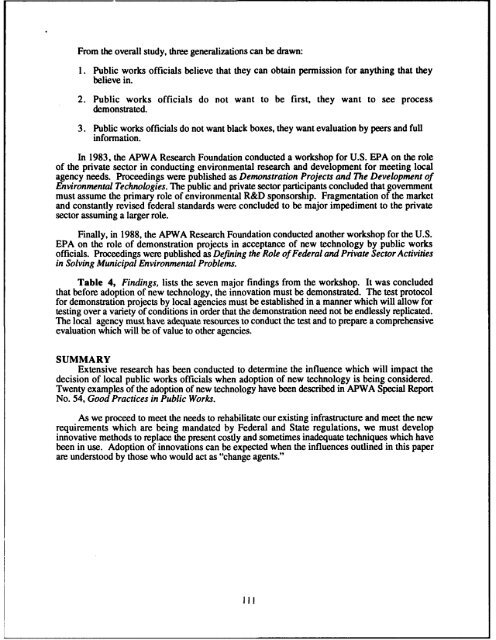Challenges and Opportunities for Innovation in the Public Works ...
Challenges and Opportunities for Innovation in the Public Works ...
Challenges and Opportunities for Innovation in the Public Works ...
You also want an ePaper? Increase the reach of your titles
YUMPU automatically turns print PDFs into web optimized ePapers that Google loves.
From <strong>the</strong> overall study, three generalizations can be drawn:<br />
1. <strong>Public</strong> works officials believe that <strong>the</strong>y can obta<strong>in</strong> permission <strong>for</strong> anyth<strong>in</strong>g that <strong>the</strong>y<br />
believe <strong>in</strong>.<br />
2. <strong>Public</strong> works officials do not want to be first, <strong>the</strong>y want to see process<br />
demonstrated.<br />
3. <strong>Public</strong> works officials do not want black boxes, <strong>the</strong>y want evaluation by peers <strong>and</strong> full<br />
<strong>in</strong><strong>for</strong>mation.<br />
In 1983, <strong>the</strong> APWA Research Foundation conducted a workshop <strong>for</strong> U.S. EPA on <strong>the</strong> role<br />
of <strong>the</strong> private sector <strong>in</strong> conduct<strong>in</strong>g environmental research <strong>and</strong> development <strong>for</strong> meet<strong>in</strong>g local<br />
agency needs. Proceed<strong>in</strong>gs were published as Demonstration Projects <strong>and</strong> The Development of<br />
Environmental Technologies. The public <strong>and</strong> private sector participants concluded that government<br />
must assume <strong>the</strong> primary role of environmental R&D sponsorship. Fragmentation of <strong>the</strong> market<br />
<strong>and</strong> constantly revised federal st<strong>and</strong>ards were concluded to be major impediment to <strong>the</strong> private<br />
sector assum<strong>in</strong>g a larger role.<br />
F<strong>in</strong>ally, <strong>in</strong> 1988, <strong>the</strong> APWA Research Foundation conducted ano<strong>the</strong>r workshop <strong>for</strong> <strong>the</strong> U.S.<br />
EPA on <strong>the</strong> role of demonstration projects <strong>in</strong> acceptance of new technology by public works<br />
officials. Proceed<strong>in</strong>gs were published as Def<strong>in</strong><strong>in</strong>g <strong>the</strong> Role of Federal <strong>and</strong> Private Sector Activities<br />
<strong>in</strong> Solv<strong>in</strong>g Municipal Environmental Problems.<br />
Table 4, F<strong>in</strong>d<strong>in</strong>gs, lists <strong>the</strong> seven major f<strong>in</strong>d<strong>in</strong>gs from <strong>the</strong> workshop. It was concluded<br />
that be<strong>for</strong>e adoption of new technology, <strong>the</strong> <strong>in</strong>novation must be demonstrated. The test protocol<br />
<strong>for</strong> demonstration projects by local agencies must be established <strong>in</strong> a manner which will allow <strong>for</strong><br />
test<strong>in</strong>g over a variety of conditions <strong>in</strong> order that <strong>the</strong> demonstration need not be endlessly replicated.<br />
The local agency must have adequate resources to conduct <strong>the</strong> test <strong>and</strong> to prepare a comprehensive<br />
evaluation which will be of value to o<strong>the</strong>r agencies.<br />
SUMMARY<br />
Extensive research has been conducted to determ<strong>in</strong>e <strong>the</strong> <strong>in</strong>fluence which will impact <strong>the</strong><br />
decision of local public works officials when adoption of new technology is be<strong>in</strong>g considered.<br />
Twenty examples of <strong>the</strong> adoption of new technology have been described <strong>in</strong> APWA Special Report<br />
No. 54, Good Practices <strong>in</strong> <strong>Public</strong> <strong>Works</strong>.<br />
As we proceed to meet <strong>the</strong> needs to rehabilitate our exist<strong>in</strong>g <strong>in</strong>frastructure <strong>and</strong> meet <strong>the</strong> new<br />
requirements which are be<strong>in</strong>g m<strong>and</strong>ated by Federal <strong>and</strong> State regulations, we must develop<br />
<strong>in</strong>novative methods to replace <strong>the</strong> present costly <strong>and</strong> sometimes <strong>in</strong>adequate techniques which have<br />
been <strong>in</strong> use. Adoption of <strong>in</strong>novations can be expected when <strong>the</strong> <strong>in</strong>fluences outl<strong>in</strong>ed <strong>in</strong> this paper<br />
are understood by those who would act as "change agents."<br />
IIl







